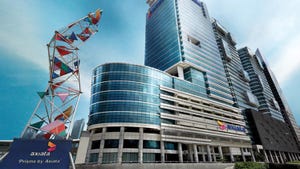Broadwing is the first customer of Tellabs' 6400, which it acquired when it bought Ocular Networks
May 30, 2002

Tellabs Inc. (Nasdaq: TLAB; Frankfurt: BTLA) announced Thursday that Broadwing Inc. (NYSE: BRW) has bought and is using the Tellabs 6400 transport switch in its network (see Broadwing Picks Tellabs Switch). This marks the first announced customer for the 6400, which Tellabs got when it bought Ocular Networks for $355 million in cash and stock in November 2001 (see Tellabs Nabs Ocular). Financial details were not disclosed.
Given this deal and some others in the pipeline, Ed Kennedy, senior VP of Tellabs' metropolitan networking group, says Tellabs is well on its way to meeting its stated goal of bringing in $50 million to $100 million in revenues from the Ocular acquisition by the end of 2002 (see Kennedy Takes Charge at Tellabs). "I'm very comfortable with that range," says Kennedy. "This is a nice win for us."
"Given the local exchange carrier portion of Broadwing, it's a service provider that has some sustainability in the market," says Jim Parmelee, an analyst at Credit Suisse First Boston. He adds that the Tellabs 6400 is probably on its way to some Tier 1 carrier wins during the second half of this year.
The Tellabs 6400 is a metro edge device that combines a digital crossconnect, an optical add/drop multiplexer (ADM), and data transport for Ethernet and Internet Protocol (IP) traffic.
When Ocular first began, the product was just one of many MSPPs (multiservice provisioning platforms) with a protocol-independent backplane that was targeting newer service providers, such as CLECs. It fit into the class of systems that utilized Sonet connectivity, DWDM, and standard Ethernet and CPE interfaces with Layers 2 and 3 data intelligence in order to help carriers provision a range of services and bypass the Sonet network (see Key Sonet MSPP Features ).
But Ocular changed directions and produced a next-generation ADM and digital crossconnect that was marketed as a replacement to the formidable Tellabs 5500 product, a hulking box that grooms voice and data traffic over Sonet networks. Now the Tellabs 5500 will be used in larger points of presence or central offices, while the 6400 is aimed at smaller POPs closer to the edge and access portions of the network.
The win with Broadwing indicates that the 6400 really does have a small enough price and footprint to make sense for grooming traffic in a Tier 2 or Tier 3 city.
In Broadwing's network, the 6400 is "bringing the crossconnect function much closer to the customer," according to Ed DeLong, Broadwing's VP of network planning and engineering. "It's driving demand for DS1 deployment much higher than the trajectory it was on before."
DeLong says that for a traditional "big iron" crossconnect, such as Alcatel SA's (NYSE: ALA; Paris: CGEP:PA) 1631 switch, it takes six racks of equipment to support the minimum configuration. The Tellabs 6400 can accomplish the same thing in one third of one rack, he says.
"That's why Tellabs bought Ocular and that's why Alcatel bought Astral Point," DeLong says (see Alcatel Acquires Astral Point -- Cheap).
Ocular "hit the right market at just the right time," says Christopher Nicoll, VP of telecom infrastructure at Current Analysis. "From an application perspective, [the Broadwing installation] is the reason Ocular came into being."
— Phil Harvey, Senior Editor, Light Reading
http://www.lightreading.com
You May Also Like


.jpeg?width=300&auto=webp&quality=80&disable=upscale)






